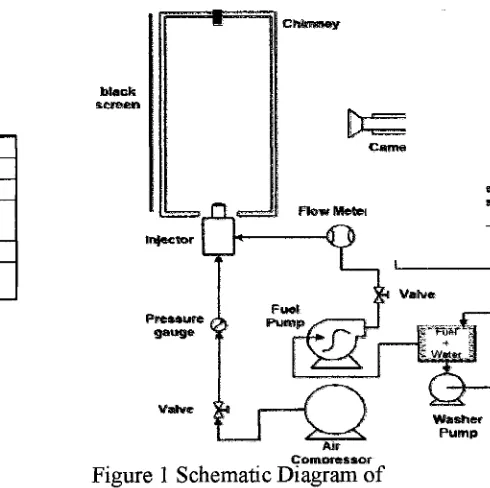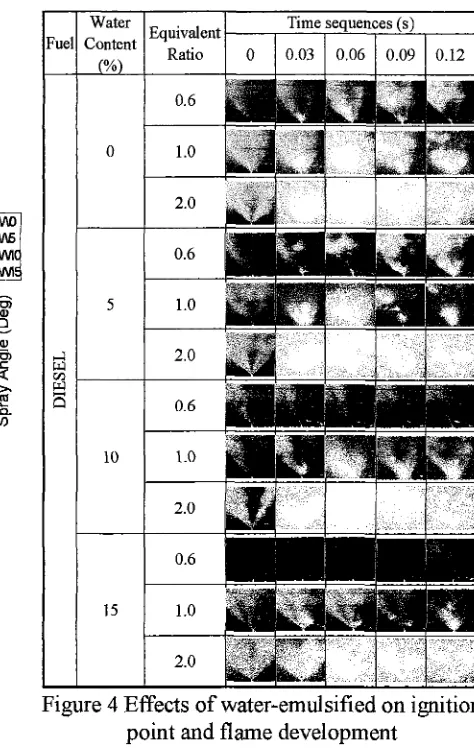Spray Characteristic of Diesel-Water Injector for Burner System
'Automotive Research Group (ARG), '~nergy Technologies (EnRG), Centre for Energy and Industrial Environment Studies (CEIES), Universiti Tun Hussein Onn Malaysia, Parit Raja, Batu
Pahat, 86400 Johor, Malaysia.
aamirk@uthm.edu.my, bfarids@uthm.edu.my
Keywords: Diesel; Burner combustion; Mixture formation; Spray penetration; Flame development
Abstract. NOx and PM are the major product results from the combustion of diesel either in internal combustion engine or external burner system. Thus, the emulsification concept from diesel and water were studied with focusing in controlling of combustion process in order to minimize the harmful emission. The main purpose of this research is to investigate the effects of diesel-water emulsification on mixture formation, burning process and flame development in burner system. The studed parameters include equivalent ratio, water content in diesel-water emulsification and spray characteristics such as spray penetration length, spray angle and spray area. The spray image of different diesel-water ratio and equivalence ratio can be investigated by direct photography method with a digital camera. The real spray images with the time changes was analyzed and compared with based diesel fuel. The results show that the higher of water contents due to higher viscosity influences the higher penetration length and lower spray angle thus predominantly the lower combustible mixture and lower the flame penetration.
Introduction
The growth of the economy and world population have driven the use of energy and natural resources. Diesel as one of the natural resources is being consumed heavily in the world demand. It can be used in many applications such as fuel in automotive and burner system. However, Soot- NOx trade off plays as a key element in controlling the combustion process in external burner system that can cause serious problems on the environment and human health[l-41. Therefore, the improvement of diesel combustion with controlling of combustion process is urgently required. For that reason, the study in fuel-air mixing and spray characteristics are necessary before the combustion process takes place. The simplest method to control the emission is by adding water in diesel, which is also known as diesel-water emulsion process. Diesel-water emulsion is the simpler and cheapest way to reduce the emission of combustion[3]. Several attractive benefits are associated with the adoption of the diesel-water emulsified. The heat absorption by water vaporization causes a decrease of local adiabatic flame temperature. During this phenomenon, water can weakens the peak temperature of luminous flames during diffusion process thus decrease the NO, emissions[5].
In addition, the fuel is vaporized to a small particular after the explosion of water droplets, this is named as micro-explosion phenomenon [3-41. Micro-explosion is occurs during the mixing of water and fuel, it's made up of two or more liquids with relatively large differences between their boiling temperatures. Heat absorption by water vaporization causes a decrease of local adabatic flame temperature and reduction of peak flame temperature that associated with lower the PM emissions and produces less toxic emission. Nevertheless, another effect of water emulsification is it tends to increase the surface tension and viscosity of the fuel, which makes the fuel hard to break up. Emulsification enhanced air-fuel mixing during the dffusion combustion phase[6]. During the fuel-air premixing, the spray quality which is the droplet size, diesel-water emulsion can produce good fuel droplet size which will enhance the spray atomization and hence reduce the PM emission. Air-fuel ratio is the key factor to control the combustion process and also the level of PM released. The benefits of having vapor state fuel induction are air and vapor mixing produce a homogeneous
mixture, the uneven hstribution of the air-fuel mixture can be avoided due to decrease of time of combustion. Some author reported that spray atomization can be enhanced if the diameter of holes of the nozzle is smaller, which it will produce more homogeneous mixture during spray forrnation[7-81. In addtion, the increment of injection pressure can promote the combustion efficiency which the heat release found that was highest[8]. The reason behind of this is because the high injection pressure will produce fine droplets and this improves the fuel and air atomization, hence the soot and HC emission is decreases. The increment of the equivalent ratio, the soot emission also increases, however, the figure show that soot emission on fine droplets is much lower than the large droplets, and thus it proved that fine droplets have significant effects on soot reduction[9]. In this research, the spray characteristic of the water-diesel mixture was investigated using the newly developed injector with the water-diesel content and equivalent ratio of the emulsified diesel. Spray characteristic such as spray angle and penetration length were investigated due to the important parameter influences in combustion process that will influences to the NOx and P M emission behaviors.
E~periInental Setup
Table 1 shows the physical and chemical properties of diesel used in this experiment. The density of No. 2 diesel fuel is 830 kg/m3. A schematic view of the experimental set up and the operating conditions including the nozzle parameter are shown in Fig 1 and Table 2, respectively. As seen in Fig.1, the injector is equipped with one air compressor and two electrical pumps. The water-diesel- air premixing injector was firstly designed by Y. Kidoguchi [19]. Air flow rates and fuel flow rates are controlled by control valve and a voltage regulator respectively.
Table 1 Fuel Properties
( No. 2 Diesel ( Chemical Formula ClzHz3
1
coefficient, K"
Lower Heating Value,
[image:2.597.262.507.404.648.2]R-=
camsFigure Schematic Diagram of ~ o m n r e s s o r
washm
Pump
spray image. The spray characteristic which includes penetration length and spray angle is analyzed image processing technique and only one hole from the nozzle will be analyzed. A few sets of spray image from Qfferent flow rates and water content are taken and compared. In this study, the injection air pressure and ambient density are kept constant at 0. lbar and 300K respectively.
[image:3.599.76.517.159.530.2]Figure 2 Mixture formation of diesel-water
Table 2 Experimental parameter and operating conditions
~ i r
1
ModelI
PUMAI
I
I
Pressure, kg/cm21
8I
Compressor
Washer
Fuel Pump
D C Voltage
I
XN2040Capacity, Llmin
I
200Pressure, bar Flow rate, L/Hr
Model CNY-3 805
Pressure, bar 3
Flow rate, L/Hr
1
1151
Model1
TeletronTC-1
Regulator
Operating condition
kglm3
I
Equivalent ratio1
0.6-2.01
Current, A Air Pressure, bar Air Density,
Ambient
Temperature, K
Water Percentage
1206A 64 (max)
0.1 1.16
3 00
0-15%
1njecGr
Result and Discussion
An effect of the diesel emulsified on mixture formation was firstly investigated. Figure 2 compares images of direct photographs with the time changes. The time indicate in the images is referring to the time start of injection. The direction of the spray of diesel fuel is upward from the injector when the supply mixtures are pumped into the injector. The experiments with real images photography with avoided the combustion were conducted to observe the behavior of spray itself especially the spray characteristics such as spray penetration, sprang angle and spray interference. As seen in Fig. 2, the spray formation of WO, W5, W10 and W15 in equivalent ratio 0.6 (lean), 1.0 (stoichiometric), and 2.0 (rich). The volume of spray increases with time and drawn by the ventilation system. At hi& equivalent ratio, the spray image becomes clearer due to the increment of the flow rate of the mixtures. This indicates that more fuel is being injected into the injector and the spray contains more fuel compared to the spray of low equivalent ratio. Furthermore, the penetration length shows an increasing trend with equivalent ratio for each type of water content, while the spray angles remain unchanged. In addition, water content varies from WO to W15 for same equivalent ratio, the penetration length and spray area increase gradually. Thus, when the penetration length increases, the spray area will increase as well. The spray angle becomes narrower when the water content increases, but it does not give significant effect on the spray area since the differences of angle are small and can be assumed to be constant. Therefore we can conclude that the spray area is only
mm
dependent by penetration length.
Holes
Volume, cc
8
5.9
Figure 3 Effects of water-emulsified on spray characteristics
Figure 4 Effects of water-emulsified on ignition point and flame development
0.06 seconds after start of ignition, the flame structure for all fuels and all equivalent ratios expands its flame area and then shrinking at 0.09 seconds and then becomes constant and developed flame pattern.
Conclusion
In this research, a fundamental study on the characteristics of diesel combustion was carried out using a burner system by changing water content and equivalent ratio. Discussions were made on relation between water-emulsified into mixture formation and flame development during burning process. Results are summarized as follows;
1. Higher water content in the mixture will result in longer penetration length and smaller spray angle. Penetration length will affect the spray area, where longer length will produce larger spray area. Increased of flow rate makes the diesel intensity of spray increases. The increment of equivalent ratio, more fuel is being injected and hence the concentration of diesel fuel in the mixture increases.
2. Flame penetration of the combustion for pure dlesel is higher than other diesel-water mixtures. Apart from that, when larger flame area produced by higher equivalent ratio, as this may be employed as a qualitative measure of the enhancements of fuel-air mixing.
Acknowledgements
The authors also would like to thank the Universiti Tun Hussein Onn Malaysia for the Short Term Grant (STG) VOT.0999 and Ministry of Higher Education, Malaysia for supporting this research under COE-MTUN Grant Scheme VOT.CO10 and Fundamental Research Grant Scheme (FRGS) vot. 1054.
References
[I] D. T. Hountalas, G C. Mavropoulos, T. C. Zannis, and S. D. Mamalis, "Use of Water Emulsion and Intake Water Injection as NOx Reduction Techniques for Heavy Duty Diesel Engines," vol. 2006, no. 724,2006.
[2] Amir Khalid and Bukhari Manshoor, "Analysis of Mxture formation and Flame Development of Diesel Combustion using a Rapid Compression Machine and Optical Visualization Technique", Applied Mechanics and Materials Vols. 3 15(2013), Trans tech Publications, Switzerland, pp 293-298
[3] Y. IGdoguchi, T. Yatsufusa, and D. Nakagawa, "Improvement of Emissions and Burning Limits in Burner Combustion using an Injector on the Concept of Fuel-water Internally Rapid Mixing," in European Combustion Meeting, 201 1.
[4] T. Yatsufusa, T. Kumura, Y Nakagawa, and Y Kidoguchi, "Advantage of Using Water- Emulsified Fuel on Combustion and Emission Characteristics," in European Combustion Meeting, 2009, pp. 2-7.
[5] D. Toncu, S. Virgl, and G. Toncu, "Combustion Study of Water-in-Kerosene Emulsions," vol. 5, no. 2, pp. 169-178,2012
[6] K. Kannan and M. Udayakumar, "NOx and HC Emission Control Using Water Emulsified Diesel in Single Cylinder Diesel Engine," vol. 4, no. 8, pp. 59-62, 2009.
[7] W. C. M. Sekaran, "Transient State Fuel Injection - A New Concept with Different Fuel Combinations," in Interdisciplinary Research and Development, 20 11 June, pp. 461-467.
[8] K. a. Subramanian, "A comparison of water-diesel emulsion and timed injection of water into the intake manifold of a diesel engine for simultaneous control of NO and smoke emissions," Energy Conversion and Management, vol. 52, no. 2, pp. 849-857, Feb. 201 1.


